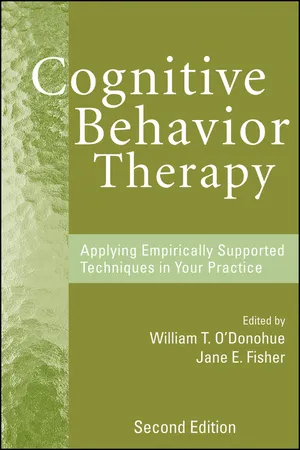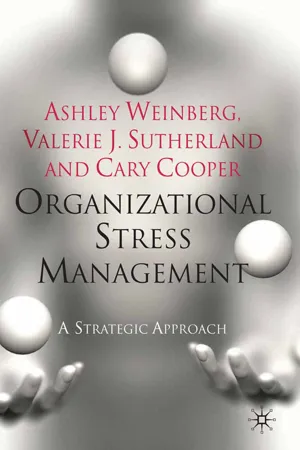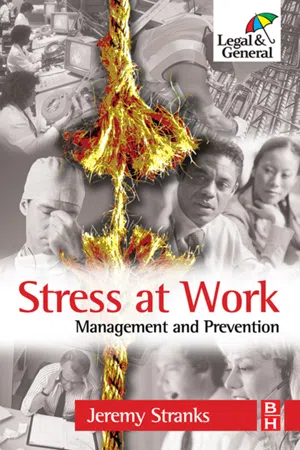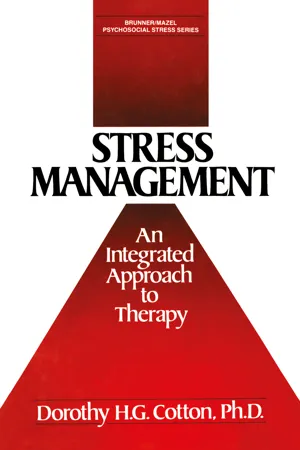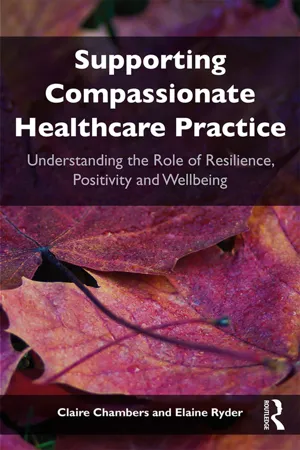Psychology
Stress Management
Stress management refers to the techniques and strategies individuals use to cope with and reduce the negative effects of stress on their mental and physical well-being. This may involve practices such as mindfulness, exercise, time management, and seeking social support. Effective stress management can help individuals build resilience and improve their overall quality of life.
Written by Perlego with AI-assistance
Related key terms
Related key terms
1 of 4
Related key terms
1 of 3
9 Key excerpts on "Stress Management"
- eBook - ePub
- Mei-yung Leung, Isabelle Yee Shan Chan, Cary Cooper(Authors)
- 2014(Publication Date)
- Wiley-Blackwell(Publisher)
6 Stress Management6.1 Coping Behaviours
When talking about ‘stress’, people generally mean overstress and its effects. Although too much stress (overstress) can result in burnout, too little stress (understress) can also affect the performance of construction professionals through rustout (Haynes and Love 2004; Lingard 2003). Therefore, stress often plays a harmful role in terms of performance and, simultaneously, a motivating role for improving performance. Construction personnel’s stress should not be simply eliminated completely, but managed in order to optimise their performance.Extending this to some circumstances means balancing various aspects of individual life, including work, relationships and leisure, as well as balancing the physical, intellectual and emotional aspects of life. For instance, people who are successful in managing stress think of life as a challenge rather than as a series of irritations. Human beings react to stress with different behaviours (Cohen, Kessler and Gordon 1995; Keavney and Sinclair 1978). Reactions to stress are not simply ‘what you should, would or could do’, but ‘what you in fact do as you react to particular conditions and demands’ (Schafer 2000). Thus, Stress Management is an ongoing and dynamic process, involving the appraisal process for the stress and one’s own possibilities for dealing with it and the strategies to handle it (Lösel and Bliesener 1990). Hence, ‘coping with stress’ refers to people’s cognitive and behavioural efforts to manage the environment, internal demands and the conflicts between them (Djebarni 1996; Lazarus and Folkman 1984).Among the various coping theories, the transactional model of stress and coping developed by Lazarus and Folkman (1984) is one of the most widely recognised and used. According to this model, there are three stages of coping: primary appraisal, secondary appraisal and coping. In the primary appraisal stage, people decide whether they are potentially threatened or in jeopardy in a particular situation that is worth being concerned about. The coping process will end if the situation is judged to be irrelevant or trivial. In contrast, if the circumstance is meaningful and potentially threatening, the stress-coping process will continue into the secondary appraisal stage, in which people assess their resources for dealing with the stressors. This stage depends on the previous experiences of the individual in similar environments, generalised beliefs about oneself and the environment, the availability of resources to deal with the situation and an assessment of the degree of control over the situation (Holroyd and Lazarus 1982; Schafer 2000). The lesser the available resources and the perceived control, the more threatening the situation is and thus the greater the probability of mental and physical distress. When people perceive a situation to be taxing or exceeding their ability to adapt, the process continues to coping, the third stage, in which they take whichever actions seem appropriate to deal with the situation (Stein et al. 1997). This can include physical actions and cognitive adjustments. However, the effectiveness of these actions is another matter (Frese 1986; Krohne 1986; Laux 1986; Schafer 2000). - eBook - ePub
- Jack Dunham(Author)
- 2003(Publication Date)
- Routledge(Publisher)
Chapter 10Stress Management
There is growing concern among teachers about the increasing mental, physical and emotional costs of stress at work. Their concern is reflected in the number of objectives related to stress which teachers want to achieve on my management courses, such as learning:- how to avoid stress;
- coping strategies;
- how to help people smile and stay sane;
- how to improve the quality of life within school;
- how to reassure colleagues;
- survival skills;
- how to provide active support for colleagues.
This chapter uses these objectives as its targets and presents a framework to achieve them. Teachers have found it helpful in preparing, developing, practising and monitoring the beneficial effects of personal and whole school Stress Management programmes and policies. This framework has six parts:- accepting the existence of stress in themselves and their colleagues caused by work pressures;
- learning to understand what stress is;
- beginning to tackle the problem by identifying the work pressures which are sources of stress;
- recognising the signs of stress which are the reaction to these negative pressures;
- identifying the coping strategies and resources which teachers use to reduce work pressures and the signs of stress;
- developing personal and whole-school Stress Management programmes and policies.
ACCEPTANCE OF STRESS
A primary teacher emphasised the importance of this first step in a Stress Management programme:A secondary teacher wrote of the stigma which is still associated with stress:I have learned not to be too proud to ask for help. I now know that acknowledging anxiety to yourself and expressing it to the right people is the first step in relieving it. Having had a complete breakdown I would plead with anyone to acknowledge stress long before it gets to that stage.It seems to me that the most important aspect of coping with stress must be the recognition by an individual that stress is part of his/her problem. One’s colleagues in the staffroom exhibit many symptoms which I would now associate with stress. I think that many of the sufferers would deny that they were prone to such weaknesses. - eBook - ePub
Cognitive Behavior Therapy
Applying Empirically Supported Techniques in Your Practice
- William T. O'Donohue, Jane E. Fisher, William T. O'Donohue, Jane E. Fisher(Authors)
- 2008(Publication Date)
- Wiley(Publisher)
Individuals use arousal reduction techniques to improve their physiological response to stress and cognitive behavioral techniques to cope better with current and future stressors. Clients often commit to changing systematic variables to reduce exposure to stressors and commit to other positive lifestyle changes (e.g., diet and exercise) in order to improve their general quality of life. All of these components are bundled into parsimonious individual behavioral plans. Typical Stress Management interventions include small-group treatment, 6-19 sessions in length that average 10-15 hours of client exposure to treatment (Ong, Linden, & Young, 2004). Generally, Stress Management interventions include teaching the clients six different techniques, which means that clients only spend 1-2 hours on each technique, providing exposure to alternative behaviors and some skill acquisition rather than mastery of any one technique. STEP-BY-STEP PROCEDURES Assessment Stress Management interventions must start with an assessment phase. Whether assessed by self-report during the clinical interview or by pencil-and-paper measures it is important to comprehensively assess the health, daily responsibilities, family and social functioning, and coping repertoires of each individual. This information is central to developing a comprehensive behavioral plan. • Self-report measures of health : Given the relationship between stress and health mentioned earlier, it is vital to thoroughly assess an individual’s general health and health behaviors. The presence of health-promoting and -reducing behaviors (e.g., poor diet, substance use, lack of exercise) may compromise an individual’s ability to cope with stress. These health-compromising behaviors may be demonstrative of existing maladaptive coping strategies (e.g., drinking alcohol to get to sleep) that may act as barriers to successful treatment - eBook - ePub
Organizational Stress Management
A Strategic Approach
- A. Weinberg, V. Sutherland, C. Cooper(Authors)
- 2015(Publication Date)
- Palgrave Macmillan(Publisher)
It is worth remembering that stress and pressure are an inevitable part of living and working, but distress is not! Our lives continue to become more complex. Like death and taxes, organization change will continue to be a feature of life in the twenty-first century and, thus, a potential source of stress. However, it is mismanaged stress that is damaging in its consequences. Both preventive and curative Stress Management strategies are essential in an organizational approach to stress control in the workplace, with education about psychological health, sound management skills and flexible working at their heart. Increasingly, evaluation studies indicate that prevention is more effective AND cheaper than trying to cure problems and victims of exposure to stress.Undoubtedly, Stress Management in the workplace must be the joint responsibility of both the organization and the individual. Both parties have a duty of care, and need to exercise this obligation in order to remain healthy and free from harm. Ultimately, the effective management of potential sources of stress is about being in control of the pressures in one’s life. While change will continue to exert a considerable force on our working lives, it must be acknowledged that some degree of pressure is inevitable and can be the spur to improved performance and motivation. Stress is a dynamic process, and this means that strategic Stress Management is not a one-off project. It must become an ongoing process within the organization based on awareness, analysis and action. To be successful, it must become part of day-to-day management and practice, and embedded within the culture of the organization. Ultimately, this is the only effective and cost-efficient strategy to avoid the unacceptable costs of distress in the workplace.We need to understand the nature of stress at work before we can eliminate or moderate it. A stress control program can be effective, if resources are targeted to specific problems and aimed at the elimination of the source of stress. Those organizations that recognize the high costs of mismanaged stress in the workplace, and seek to achieve enhanced levels of effectiveness and the well-being of their workforce, will adopt this integrated approach to Stress Management. It embraces both individual coping and organizational change to combat the problems associated with stress at work. If we can successfully coordinate both levels, we might be able to enact the words of Gandhi and “Be the change you wish to see in the world.” - Rabi S. Bhagat, James Segovis, Terry Nelson(Authors)
- 2016(Publication Date)
- Routledge(Publisher)
Companies such as Covington Associates LLC, a specialty investment bank in Boston, Massachusetts, and Burgess Advertising and Marketing in Portland, Maine, along with many other companies have recognized for some time these potential benefits in the workplace. One in five companies allows companion animals in the workplace, according to one nationwide 2006 survey by the American Pet Products Manufacturers Association (Noblett, 2008). In that survey, it was reported that 73% of respondents felt that pets created a more productive work environment; 100% reported that employees were more relaxed because of the presence of an animal; 73% reported that they felt it increased creativity of employees; and 96% felt that it created an overall positive workplace. Wells and Perrine (2001a) substantiated this finding in a survey of 131 employees from 31 companies allowing pets in the workplace. People perceived that pets made for a more pleasant work environment and even helped relax customers into being more interactive. However, though most people enjoyed the benefits of pets, it should be noted not all workers and customers shared the same positive feelings about the presence of pets. Despite these overall promising positive survey statistics about companion animals in the workplace, there exists only a small number of peer-reviewed academic investigations of this phenomenon in contrast to the large number of therapeutic studies of ATT (Wilson & Barker, 2003). What does exist about workplace companion animals is mainly suggestive about their potential as a Stress Management tool. Barker et al. (2005) found that stress was reduced in 20 health-care professionals with as little as 5 minutes of interaction with a therapy dog. Somervill, Kruglikova, Robertson, Hanson, and MacLin (2008) also discovered that college students holding animals for 5 minutes could significantly decrease their diastolic blood pressure. In another study by Wells and Perrine (2001b) about the presence of pets in faculty offices, students in general perceived the office as more comfortable and the faculty member friendlier even when they just looked at slides of animals with the faculty member. Given these exploratory research investigations, it would be fruitful to expand this line of stress research. In addition to companion- or pet-assisted activities, organizational stress researchers should consider exploring the use of music as another nontraditional Stress Management tool in the workplace for employees. Music therapy research has found positive results for reducing anger (Jackson, 2010), burnout (Brooks, Bradt, Eyre, Hunt, & Dileo, 2010), pain (Bailey, 1986), and especially the risk factors associated with heart disease (Bradt & Dileo, 2009). Each of these lines of thinking, whether it concerns companion animals, music, religion, or pharmaceutical drugs, builds our vision of a holistic model in creating a richer understanding of Stress Management and coping in organizations. Moreover, researchers will capture more in their Stress Management models what many lay people already practice in managing the daily effects of their stressors at work or at home.Conclusion
As discussed in this chapter, it is necessary to view the process of Stress Management as part of a much larger complex physical, psychological, and social system. The Transformational Model of Stress Management provides us a road map to accomplish this objective, especially in building healthy organizations. Western Stress Management interventions, as found in the chapters of the Handbook of Workplace Stress (Barling et al., 2005) and the Handbook of Occupational Health Psychology (Quick & Tetrick, 2003, 2010), offer a number of positive ways organizations and individuals can reduce the impact of stressors at work and in one’s personal life. However, we need to think in a more holistic manner about the range of these interventions if we are to be more successful in our management of stressors and our ability to cope more fruitfully. Our research and interventions need to reflect a more interdisciplinary approach of medicine (physical), psychology (mental health), and religious (spiritual). This model allows researchers to gauge the level of effect a primary, secondary, or tertiary intervention has at different levels of mastery, meaning, social–community connections, positive self-regard, and symptom management in a particular situation. It suggests a more flexible approach for practitioners to determine how to approach any workplace stressor but in a much more comprehensive manner looking at both eustress and distress. Quick et al.’s (2007) healthy organization and Antonovsky’s (1987, 1996) salutogenic- eBook - ePub
- Raschel Larsen(Author)
- 2022(Publication Date)
- Chemeketa Press(Publisher)
When we say “coping,” we typically mean how someone responds to a stressor, but this term can also refer to proactive strategies that help people avoid or eliminate the impact of stressors—these strategies may help them look at a stressor in a different light. How a person chooses to cope depends upon their personality traits and type, the social context, and the nature of the stressor presented.According to psychologists, though theories differ on how people cope, there are some consistencies within these theories related to how we approach the stressor. We tend to approach them in three distinct ways: through how we appraise the problem, how we problem-solve, and how we use our emotions as we strategize.Appraisal-focused strategies attempt to change the way you look at the stressor and approach it differently, sometimes questioning your goals and values. Problem-focused strategies strive to deal with the cause of the stressor, work through the problem, and in doing so remove the source of the stress or learn skills to manage it. Emotion-focused strategies focus on the emotions you are having due to the stressor and attempt to modify them. This could be by releasing the emotions, distracting yourself, or actively trying to manage your mental state.Consider the following specific strategies for coping with difficult situations:- Engage in regular physical activity. Just 30 minutes of movement every day can help boost your mood and improve your health. Small amounts of physical activity add up, and short intervals can make a difference.
- Eat healthy, regular meals and stay hydrated. A balanced diet and plenty of water can improve your energy and focus throughout the day. Also, limit caffeinated beverages such as soft drinks or coffee.
- Make sleep a priority. Stick to a schedule, and make sure you’re getting enough sleep. Blue light from devices and screens can make it harder to fall asleep, so reduce blue light exposure from your phone or computer before bedtime.
- Try a relaxing activity
- eBook - ePub
- Jeremy Stranks(Author)
- 2005(Publication Date)
- Routledge(Publisher)
Everyone is subject to stress at some time in their lives. It may be associated with a range of incidents and situations, such as loss of a job, death of a loved one, problems at work, bullying and harassment by colleagues at work or simply overloading of the job.People would be much happier if they studied the causes of stress in their lives and adapted appropriate strategies for coping with these stressors. This chapter has provided a number of strategies for coping, including personal relaxation and time management, two important aspects of reducing those occasional crises that arise.Questions to Ask Yourself After Reading This Chapter- What do people need to do in order to cope more successfully with the stress in their lives?
- What does relaxation therapy entail?
- Why can organizational change be a source of stress for everyone?
- What are the effects of change on people?
- How can time management be improved?
- What do people need to do in personal crisis situations?
- Do some people need assertiveness training?
- What forms of relaxation therapy are available?
- How do people cope with changes in their personal lives?
- How do people respond to stress?
Key Points – Implications for Employers- For people to cope with the stress in their lives, they must be aware of those factors which create stress (stressors) and their specific stress responses, such as insomnia, digestive disorders or even aggressive behaviour.
- In order to deal with stress, everyone should be trained to develop their own personal coping strategies.
- Change within the organization, in job content, in the management systems and in working arrangements are some of the greatest causes of stress amongst employees.
- Better time management is one of the best ways of coping with stress at work.
- Some people, particularly those who have to deal with members of the public, may benefit from assertiveness training.
- eBook - ePub
Stress Management
An Integrated Approach to Therapy
- Dorothy H.G. Cotton(Author)
- 2013(Publication Date)
- Routledge(Publisher)
Coping, as it is defined by Lazarus and Folkman (1984), represents “the constantly changing cognitive and behavioral efforts to manage specific external and/or internal demands that are appraised as taxing or exceeding the resources of the person” (p. 178). Coping is therefore a process, not a trait. Coping is part of the process of appraisal (i.e., secondary appraisal), yet it is also part of the process of managing stress. Coping may be directed toward lessening emotional distress which is the result of a stressful encounter (called emotion-focused coping by Lazarus & Folkman), or it may be directed toward altering the definition of the problem itself by redefining the stressor (problem-focused coping).Although attempts have been made to classify and categorize coping styles which may be typical of specific individuals, it appears that on the whole, people are more variable than consistent in their use of coping strategies (Folkman & Lazarus, 1980), and that the selection of coping strategies is as much a reflection of differing contexts as it is of differing personalities.Comments. When one considers all the varying events and situations which might be construed as stressful, it is easy to conclude that everything is stressful. Yet this is clearly not the case (for most people). In spite of the disagreements and disputes evident in the above discussion, there seems to be at least one fundamental conclusion which can be drawn.Stressful events are those events which are seen to tax the capabilities of the individual. Regardless of the nature and magnitude of the event, it must be recognized and acknowledged by the individual in order for it to act as a stressor. In some cases, the role of appraisal may be minor in comparison to the role of the event itself, whereas in other cases, appraisal is the primary “cause” of stress.What Is the Stress Response?
As noted above, the stress response has cognitive, behavioral and physiological components, which are summarized in Figure 2-3 - eBook - ePub
Supporting compassionate healthcare practice
Understanding the role of resilience, positivity and wellbeing
- Claire Chambers, Elaine Ryder(Authors)
- 2018(Publication Date)
- Routledge(Publisher)
3 The Benefits of Effective Stress Management StrategiesOverview of the chapter Case Study Discussion: how do we manage stress in our lives • What is stress? • Signs of stress and negative coping strategies • Emotional labour • Particularly challenging situations • Is distancing ourselves from the people in our care the answer to reducing our stress? • Emotional burnout • Stressful care environments • Causes of stress • The costs of stress Implications for us as leaders Thoughts for your practice Summary References Overview of the chapter
So what is stress, and what are its causes and manifestations, and what are the costs of stress in today’s world to us as individuals, and to those in our care? We discuss negative coping strategies and how these relate to emotional labour and to particularly challenging health care situations. Distancing ourselves from the people in our care does not reduce stress and can lead to greater emotional burnout, and we need to recognise this in ourselves and others. We discuss positive Stress Management strategies and the benefit of mindful communication approaches. Stress reduction strategies enhance our empathy and enable us to make meaningful relationships with patients which decreases our likelihood to experience burnout.Health care environments are innately stressful because they involve caring for people who are distressed, acutely or chronically unwell and at very stressful points in their lives. In addition, we are all busy people living with lives that are busy and challenging, with many different pressures on us, and this can all seem like too much to cope with at times. If we add in the stress of working in very busy environments, with constant, and often unachievable, deadlines, and real constraints on our time, then it is not surprising that stress is endemic within our personal and professional lives.
Index pages curate the most relevant extracts from our library of academic textbooks. They’ve been created using an in-house natural language model (NLM), each adding context and meaning to key research topics.
Explore more topic indexes
Explore more topic indexes
1 of 6
Explore more topic indexes
1 of 4


